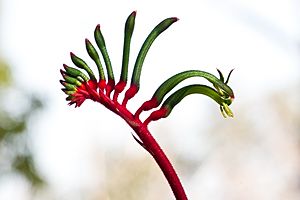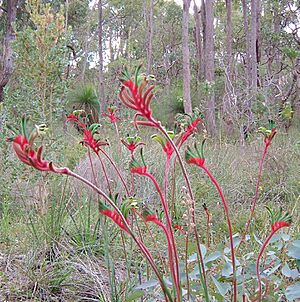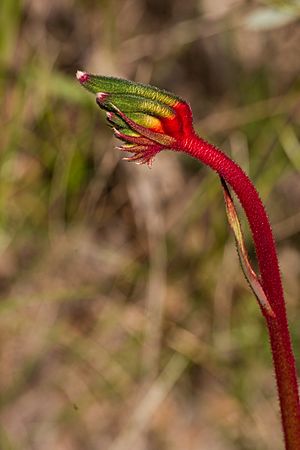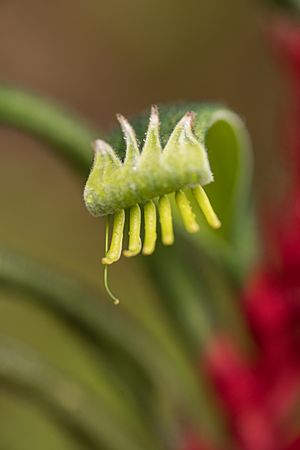Red-and-green kangaroo paw facts for kids
Quick facts for kids Red-and-green kangaroo paw |
|
|---|---|
 |
|
| Scientific classification | |
| Genus: |
Anigozanthos
|
| Species: |
manglesii
|
 |
|
| Occurrence data from AVH | |
The Anigozanthos manglesii, often called the red-and-green kangaroo paw, is a special plant found only in Western Australia. It's so important there that it's the official flower of the state! The Noongar people, who are the traditional owners of the land, call it Kurulbrang.
This unique flower is a symbol of Western Australia. You can see its tall, colorful blooms between August and November, especially in cities and along the coast. Even though it's popular, the plant is protected by state laws, so you need a special permit to collect it from the wild. People also love to use it as a cut flower because of its unusual shape and bright colors that last a long time.
Contents
What it Looks Like
The red-and-green kangaroo paw is a type of plant that grows back every year, called a perennial. It has long, grey-green leaves, usually about 30 to 60 centimeters (about 1 to 2 feet) long. These leaves grow out from a central spot close to the ground.
Its most famous feature is its red and green flowers, which appear on long stalks. These stalks can grow up to 1.2 meters (about 4 feet) tall! The flowers open one after another, starting from the bottom of the stalk. Even after the flowers fade, their stalks often stay standing for a while.
Where You Can Find It
This plant grows all over the Southwest Australian region. It especially likes sandy soils, whether they are white, yellow, or grey. You can find it in the northern parts of its range, like the Geraldton Sandplains and the Swan Coastal Plain near Perth. It also grows further south in areas like the Jarrah Forest and the Warren region, but it doesn't reach the very southern coasts. You can even find it inland in the Avon Wheatbelt.
How it Got its Name
A Scottish botanist named David Don first officially described this plant in 1834. He named it Anigozanthos manglesii after Robert Mangles, who grew the plant from seeds. These seeds were brought from the Swan River (in Western Australia) by Sir James Stirling, who was the governor of the colony at the time.
Different Types of Kangaroo Paw
There are two main types, or subspecies, of the red-and-green kangaroo paw:
- Anigozanthos manglesii subsp. quadrans Hopper: This type is found as far north as Shark Bay. It has some small differences in how it grows and its structure.
- Anigozanthos manglesii D.Don subsp. manglesii: This is the more common type, found widely from Gingin in the north down to Cape Leeuwin in the south.
Sometimes, the red-and-green kangaroo paw can naturally mix with other types of Anigozanthos plants. This creates new, mixed kinds of kangaroo paws.
Garden Varieties
People often create new types of kangaroo paws by mixing Anigozanthos manglesii with other species, especially A. flavidus and sometimes A. rufus. These specially bred plants are called cultivars, and they are popular in gardens.
Some examples of these garden varieties include:
- Autumn Mystery
- Big Red
- Bush Emerald
- Hickman’s Delight
- Rogue Radiance
- Space Age
- Sue Dixon
Growing Kangaroo Paws
If you live in a place with a mild climate, you can grow this plant outdoors. In colder winters, it might need some protection, like a layer of mulch over its roots. The seeds of the red-and-green kangaroo paw grow easily.
These plants often look their best for about two years, so some people treat them like biennial plants, meaning they replace them every couple of years. It's best to give them less water when they are not actively growing. They can sometimes get a fungal disease called ink spot, and snails also enjoy eating their leaves.
Because of their unique look and how long they last, these plants are very popular as cut flowers for bouquets and arrangements. The Royal Horticultural Society has even given this plant an award for being a great garden plant!




